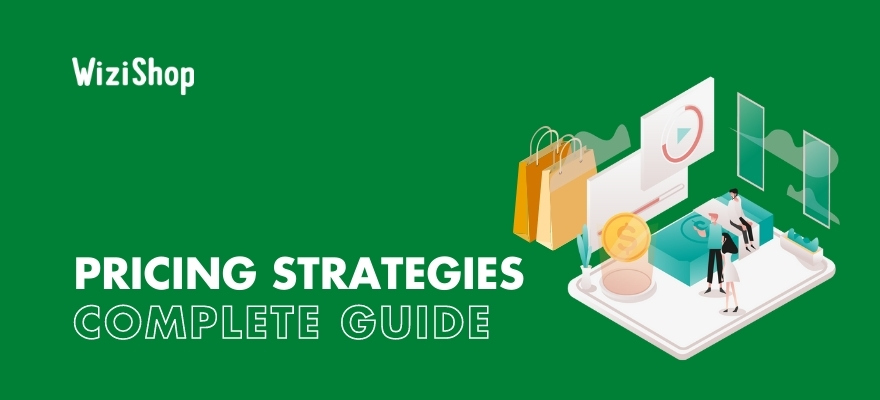Deciding what to charge for your ecommerce site’s products can be tricky.
After all, if you make the price too expensive, you might not have anybody willing to buy from you. In contrast, if you price your goods too low, you’ll probably have lots of customers but may go out of business due to your expenses eating up the profit.
It’s definitely a balancing act.
What’s more, there’s no one-size-fits-all solution to know exactly how you should be pricing your products. There are many different factors to consider, and every business, big or small, needs to do their research before selecting their approach.
Don’t worry, though—we’re here to help!
This detailed guide explains what a pricing strategy is, what to do before choosing one, and 17 common strategies to get you started. In addition, you’ll find a few real-life examples of these strategies at the end of the article to better illustrate how they work.
What is a pricing strategy?
A pricing strategy is simply the method you use to determine the best price for the product or service that you offer. It allows you to price the items that you have for sale in a way that maximizes profits and revenue while taking a myriad of factors into account, such as consumer demand, the kind of product you sell, and how much your competitors are charging.
What should you do before selecting a pricing strategy?
Deciding how much to charge for your products is a very important part of running an online store. Prior to making this decision, though, it’s a good idea for you to complete several actions to ensure that you’re making the right strategy or strategies for your business.
Determine the various costs of the product for your business
First, you’ll need to figure out how much it costs for you to be able to offer your product on your ecommerce website.
As this is the basis for many of the pricing strategies described later, it’s crucial that you understand this aspect of your business.
Do you make your products yourself? Consider how much raw materials cost to create each product. If you have products manufactured for you, you should already have a good idea of how much each item costs to produce.
Additional elements to factor into a product’s total cost include packaging, shipping, marketing, production time, etc.
Consider your business goals
A pricing strategy that works amazingly well for one online store may do zilch for you if it doesn’t help you achieve your unique objectives for your business. For this step, you’ll want to think about both your overall goals for your business as well as what you hope to achieve with each new product you decide to offer.
Keep these objectives in mind for every product launch as you choose your pricing strategy, knowing that your goals may change over time and that you may need to adapt your strategy accordingly.
Understand your target market
In line with the previous step, while it’s important to come up with objectives such as how much you hope to earn with each product sale, you also need to get a sense of how much your ideal customer will be willing to pay for that item.
For example, if you know that your target market is made up of particularly price-conscious shoppers, you may want to avoid pricing strategies that involve charging higher prices for your products from the get-go.
Know your value proposition
As you may have already discovered, there’s a lot of competition out there in the world of online sales!
The effects of the pandemic have seen an increase in businesses heading to the internet to earn a profit. If you hope to find success with your ecommerce venture, you’ll need to determine exactly what it is that makes you stand out from competing stores.
What can you provide to shoppers that your competitors can’t? Understand this and you’ll understand your value proposition. Use your value proposition to select a pricing strategy that aligns with your values and the brand image that you wish to create.
Take a look at your competitors’ pricing
Even if you’re already pretty sure you know how you’d like to price your products, it’s always advantageous to check out what your competitors are doing too. While you don’t need to necessarily use the same strategy as them, this information can better inform your decision.
First, examine the pricing strategies of your direct competitors, those stores who offer the same product as you. Then, review the strategies of your indirect competitors, those stores who offer other products that could be substituted for yours.
17 common pricing strategies
Whether you are thinking of launching a new online store or want to ensure that you have the optimal pricing strategy in place for your current shop, we want to help get you on the right track!
Here’s a list of the most common pricing strategies used today to help you decide which method(s) would work best for your ecommerce business.
1. Cost-plus pricing
A relatively simple strategy, cost-plus pricing is all about how much it costs you to produce your product. This strategy involves business owners examining their cost of goods sold (COGS), adding a fixed percentage to the cost (hence the method’s other name, “markup pricing”), and selling the product for the total amount to make a profit.
For instance, let’s pretend that your ecommerce website sells eco-friendly birdhouses. Say that it costs $5 in materials to manufacture each item, $15 for labor, $5 for marketing, and $5 for shipping, with a total cost of $30. In addition, you know that you’d like to earn a 25% profit per sale.
Here’s how you’d calculate the price that you’d charge for each item sold:
Cost of product ($30) x markup (1.25) = Total price per product ($37.50)
Is this strategy right for you?: Keep in mind that while this pricing strategy can be a good fit for online stores that sell products, it tends to not work so well for businesses that sell services. This is due to the fact that it usually costs quite a bit less to create a service than the value that service offers to clients.
2. Competition-based pricing
For this strategy, thorough competitor research is especially essential. You’ll need to take a look at what the competition is currently charging for their products and use this data as a benchmark for your own pricing. The COGS and demand for your product are less important if you opt to use competition-based pricing.
Once you do your research, you can decide if you want to charge customers an amount that’s the same as what competing stores are charging or just a bit less/greater than your competitors’ prices.
Is this strategy right for you?: This method may be perfect for your ecommerce business if there are quite a few online stores out there selling the same product as you. In saturated markets, even the smallest difference in price can push a shopper to click “Buy now” or exit a site and head elsewhere. However, it can be difficult to use this strategy if you’re new to ecommerce and can’t afford to price your products below your competitors.
3. Dynamic pricing
If you’ve done a hotel search for an upcoming holiday and noticed that the price per night is higher during certain days of the week or in certain seasons, you’ve seen dynamic pricing firsthand!
Also called “surge pricing,” “time-based pricing,” or “demand pricing,” this strategy involves the application of different algorithms to determine a price that’ll bring maximum profits while accommodating fluctuations in consumer and market demand. These algorithms also consider elements like competitors’ pricing and market supply when calculating an optimal price.
Is this strategy right for you?: This pricing strategy generally works best if you sell services rather than products. It can be challenging and expensive to manage, though, and customers may get annoyed if your prices fluctuate too frequently. Nevertheless, if you have the means to calculate algorithms and keep up with constant changes in the aforementioned factors, dynamic pricing could be very profitable for your business.
4. Value-based pricing
With this method, it’s important that you know your customers very well and understand how they view what your online store has to offer. Businesses that employ value-based pricing examine how much their target market is willing to pay and price their products accordingly.
This approach can help boost customer trust and loyalty while increasing your profits when used properly. Generally speaking, if you go with value-based pricing for your store, you should already have a well-established brand in place and have the resources to devote to creative marketing techniques.
Is this strategy right for you?: Does your ecommerce website sell unique products that may be difficult for shoppers to find elsewhere? While it can be difficult to determine the perceived value of a particular item, brands often do well with this strategy if they offer luxury products or other goods that customers believe can help improve their self-image.
5. Bundle pricing
Also referred to as “multiple pricing,” this method entails combining at least two products or services together and offering them for one price.
Customers may be more likely to pay more if they believe that they’re getting more value by purchasing multiple items at the same time. Although this pricing strategy may reduce the profits of a single item, it can help boost sales volume and be beneficial for your business in the long run.
Is this strategy right for you?: If your product catalog features items that complement each other, and your ecommerce platform can accommodate upselling/cross-selling, this strategy may work well for your business.
6. Freemium pricing
Often used for software-as-a-service (SaaS) companies, this pricing strategy generally involves selling at least two levels of services, ranging from a basic version to one with enhanced features. Businesses will often offer their basic service for free, with the goal of converting customers to the upgraded/premium paid option(s) later.
Is this strategy right for you?: For this pricing strategy to be profitable for your business, you’ll likely need to be able to offer a basic version of your service that provides value to your customers. In addition, you’ll ideally be able to devote time and other resources to nurturing your relationships with customers, building trust and loyalty.
Finally, the paid version(s) of your service shouldn’t be so expensive that there’s a huge leap from the free option. Gradual price increments work best here to entice customers to upgrade.
7. Price skimming
Businesses using this pricing strategy will charge customers the highest price they can when they first release a product. As the product’s popularity decreases over time, the product’s price lowers as well. The aim of price skimming is to skyrocket revenue in the beginning when demand is high and there’s not a lot of competition in the market.
Is this strategy right for you?: This method is frequently used by companies who sell tech products like smartphones. As technology changes so quickly, businesses strive to make money at the most opportune moments of a product’s lifetime, which tend to be at the initial release for this type of item. Keep in mind that price skimming can alienate shoppers who bought your product at full price and see it marked down 50% just a few months later.
8. Keystone pricing
Similar to cost-plus pricing, this approach entails simply taking the wholesale cost of a product and doubling it to set the retail price for that item, meaning a markup of 50%. While this keeps the process of pricing products easy for retailers, it may lead to goods being priced too low or too high for those particular businesses.
As keystone pricing doesn’t take factors like shipping costs, marketing costs, etc. into account, it’s crucial that you have a good understanding of these expenses for your products before using this strategy.
Is this strategy right for you?: If the manufacturing costs for your products are the most significant expense and you don’t have a lot of competition in your market, keystone pricing may be a good option for you. However, if your product turnover is low, you may need to use a markup of less than 50% to get an item off your shelves or out of your warehouse so that you aren’t continuing to lose money by having the product just sit there for months on end.
9. Penetration pricing
Particularly effective for businesses whose ideal customers are price-conscious shoppers, penetration pricing involves setting a very low price for products as they first break into the market.
While you won’t be able to use this pricing strategy forever, as it’s not a sustainable solution for the long term, it can be a great way to enter a competitive market and attract new customers.
Is this strategy right for you?: New online stores often employ penetration pricing to gain market share before gradually increasing the price of their products. Although profits may not be very high in the beginning with this strategy, the resulting boost in brand awareness can be well worth the temporary low earnings.
Consider that using this method too often may lead to consumers believing that you have low-value goods for sale or waiting until your products are discounted before they make a purchase.
10. High-low pricing
This method is similar to price skimming in that businesses charge a higher price for a product at the start. As the demand for the item begins to decrease, the price will drop as well. Sometimes also called “discount pricing,” high-low pricing examples include year-end and clearance sales.
The difference between price skimming and high-low pricing, however, is that while the former involves permanent price changes, the latter allows for more flexibility, with prices increasing and decreasing throughout a period of time.
A prime example of this? Black Friday!
Is this strategy right for you?: High-low pricing can be advantageous for retailers whose stores feature seasonal products or goods that frequently change. Note that if you opt to go with this approach, you should perform an in-depth analysis to determine when your products are the most in demand during the year.
11. Project-based pricing
Generally used by people who provide a service, such as consultants, contractors, and freelancers, this pricing strategy has business owners charging customers a flat fee to complete a project.
To be successful with project-based pricing, you should have a decent idea of approximately how long it’ll take for you to complete the project and be able to work efficiently.
Is this strategy right for you?: If you want to use this pricing strategy, just be sure that the requirements and specifications for the project are firmly established before you begin. Your expectations and your client’s expectations should match so that you don’t end up spending a lot of unanticipated extra time on the project or leave your client disappointed with the end result.
12. Psychological pricing
There are numerous ways that companies can use human psychology to price their products and increase their profits, some of which you’ve likely experienced as a consumer yourself!
For instance, shoppers tend to prefer odd numbers to even numbers. You’d therefore usually be more successful selling an item if you priced it at $19.99 rather than $20.
In addition, if you’re trying to sell a particular product, perhaps because it’s been sitting on the shelf for a while, you could list “similar items” on that product page, with more-expensive goods appearing. When a visitor sees that your target product is less expensive than other offerings, that may give them the push they need to purchase it.
Another way to employ psychological pricing is to make use of color theory, which involves using certain colors to convey messages or appeal to your target market.
Is this strategy right for you?: While this method can work for any entrepreneur, it’s crucial to have a good understanding of your ideal customer if you want to reap the most benefits. You need to discover what’s most important to them so that you know what factors will have the greatest impact on their purchasing decisions.
13. Geographic pricing
Geographic pricing is when businesses price products according to the customer’s location. Variables that can affect this pricing strategy include shipping costs, demand, state of the economy, etc.
The aim is generally to earn the most revenue possible in each market where the business operates. However, some companies employ this strategy to instead first increase brand awareness and loyalty in the hopes of more profits later down the road.
Is this strategy right for you?: If you’re trying to break into new markets around the world, geographic pricing can help you to attract a whole new group of customers. Keep in mind, though, that you’ll need to be careful with how you approach this strategy.
14. Hourly pricing
Just like project-based pricing, hourly pricing is often the strategy of choice for entrepreneurs providing services. It differs in that the total amount that the client pays will depend on the provider’s hourly rate and how much time it takes to complete the service rather than being a set fee.
Note that clients can sometimes be wary of this pricing method, as they may worry that a business will delay the completion of the project to ensure more money.
Is this strategy right for you?: While hourly pricing can be tricky to use when you’re starting a new business and unknown in your industry, it can be a good fit once you’ve started to build up a client base and can provide prospective clients with referrals. Reliability and efficiency are the key to success with this strategy!
15. Manufacturer-suggested retail pricing
The manufacturer-suggested retail price (MSRP) is how much a manufacturer advises that a retailer charge for a particular product. It was first used by manufacturers to help standardize the pricing of products in different locations and offered by different retailers.
Is this strategy right for you?: When you set your product’s price using the MSRP, you don’t take any other factors into account. Although this might not be an issue if you and your competitors have similar expenses, this strategy may not be the best option if you have to manage additional costs, such as shipping to international customers.
16. Anchor pricing
This method for pricing products is all about comparison. With this strategy, you display a product’s discounted price along with its original price (the anchor price). Your site visitors will see how much they’ll save by purchasing the product now.
Is this strategy right for you?: This approach works best if there’s a significant difference between the sales price and the anchor price for your product. For an item with an original price of $50, a savings of $1 may not be enough of an incentive to complete a purchase.
17. Economy pricing
With economy pricing, the goal is to earn revenue by selling lots of goods at a lower price.
It’s often used for store-brand products and generic medications. This pricing strategy is generally quite easy to put into action and calculates a product’s price in a manner similar to cost-plus pricing.
Using the same example earlier with the birdhouse store, in which it costs $30 to produce a product and you want to earn a 25% profit for each sale, the price per birdhouse would be $37.50:
Production cost ($30) x profit margin (1.25) = Total price per product ($37.50)
Is this strategy right for you?: To be successful with this approach, you need to have a constant wave of customers buying your products, as you won’t earn a significant amount per sale. It usually works best if your target market includes price-sensitive shoppers. Furthermore, your business must be able to keep the cost of acquiring customers manageable, as this cost could quickly eat into your profit margin.
Real-life examples of pricing strategies
To help you to better visualize some of these pricing strategies, here are a few examples of what they can look like in real life.
Oui.sncf: Dynamic pricing
If you’ve ever booked your own travel for a vacation or a business trip, you’ve probably noticed that transportation companies often use this pricing model. Take Oui.sncf, for instance, the official European distribution channel of the French railways.
If I want to book a trip from Nice to Paris in May, but I’m not sure of the exact date, I might decide to view the ticket prices for the entire month.
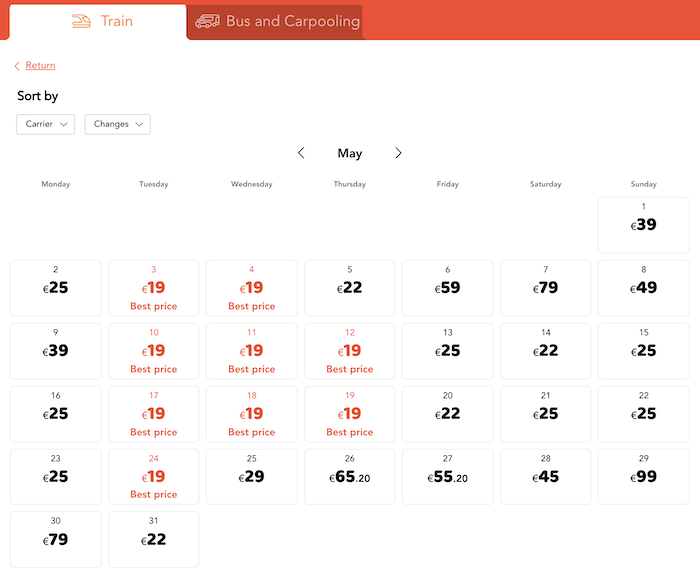
Right away, we can see that some dates are more expensive than others. Why is this?
Well, Tuesday, Wednesday, and Thursday are usually cheaper days to travel, but it’s also important to note that there are three public holidays in May in France, occurring on May 1st, May 8, and May 26 in 2022. In addition, the last Sunday in May is Mother’s Day in France.
A quick glance at the calendar above informs us that train tickets surrounding those dates are pricier, as there’s likely to be more demand then.
Everlane: Value-based pricing
American clothing retailer Everlane offers a range of men and women’s clothing, primarily online. The company is known for their sustainable practices and being candid with consumers regarding their policies and values, communicating openly about everything from the factories and materials they use to produce clothing to the price of each item they have for sale on their website.
For example, in the image below, we see that Everlane’s ‘90s Cheeky Jean will cost shoppers €110 to purchase.
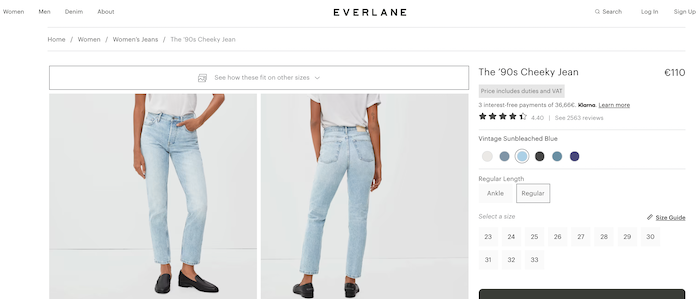
When we scroll further down the page, we come to the “Transparent Pricing” section, which details exactly what it costs the company to produce the product, with the aim of providing what Everlane describes as “Radical Transparency.”
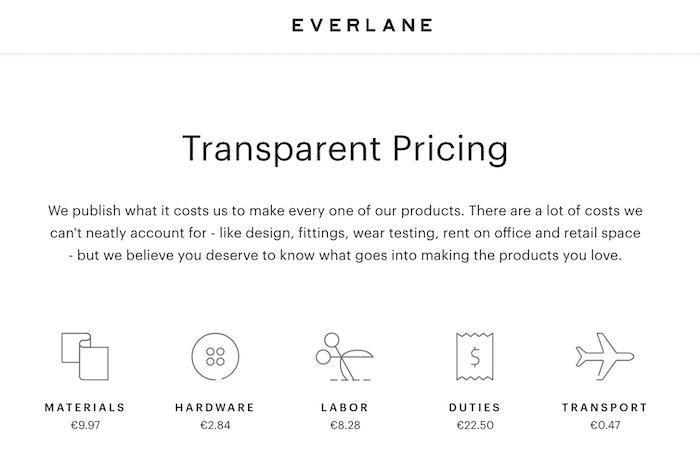
From this information, we discover that it costs Everlane a total of €44.06 to make this particular item. Although the purchasing price for the customer is €65.94 higher at €110, many shoppers don’t mind paying this because they believe the value of the product to be high.
This perceived value relates to the clothing itself but also to the trust they have in the company and the belief that they’re buying from an ethical brand.
Michaels: Bundle pricing
Michaels is a chain of arts and crafts stores that offers a wide selection of supplies to indulge shoppers’ creativity at its slew of brick-and-mortar stores across North America in addition to its website.
Consumers visiting the website have the ability to create their own product bundles with various materials. In the example below, the company advertises a “build-your-own-drawing” bundle in which visitors get to select one product in three different categories.
In this particular instance, Michaels emphasizes that the shopper could “save as much as $28” by purchasing the bundle rather than buying the items separately.
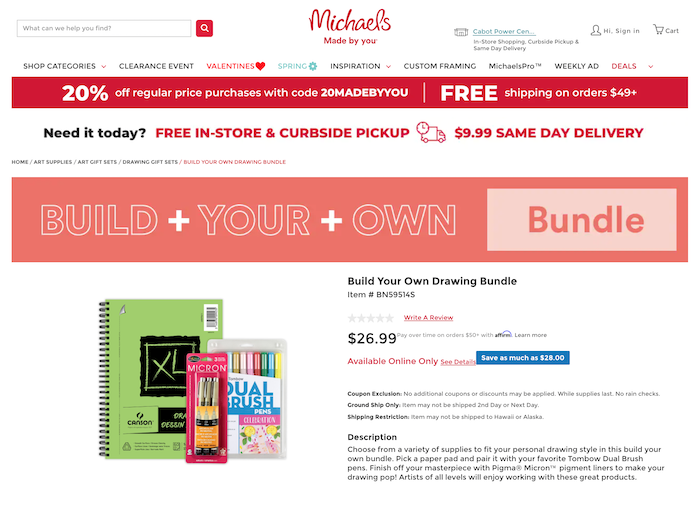
Scrolling down, we see where the shopper gets to choose the products that they wish to include in their bundle. Here, they’d select one paper pad, one market set, and one pen set.
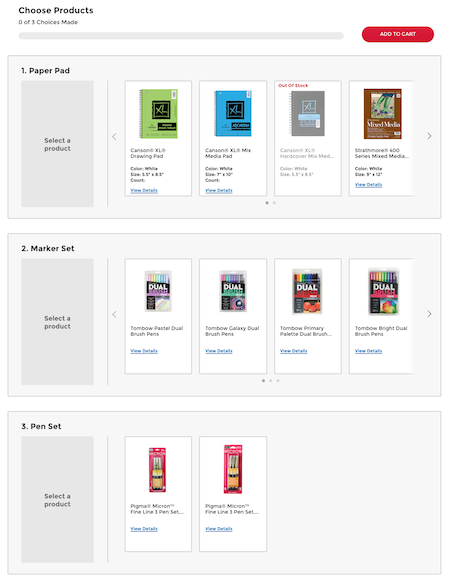
It’s true that this bundle may not be very appealing to an experienced artist who only uses a particular brand of materials for their projects. However, it’s likely that Michaels targets this product offering to beginners who may not know where to start.
Conclusion
Hopefully this article has provided you with a better understanding of the options available to you as you decide how to price the products for your online store. Remember that nothing’s set in stone, though, and it’s okay to change your approach as your business changes and grows.
Which of these pricing strategies are you planning to use for your ecommerce website? Let us know in the comments below!


